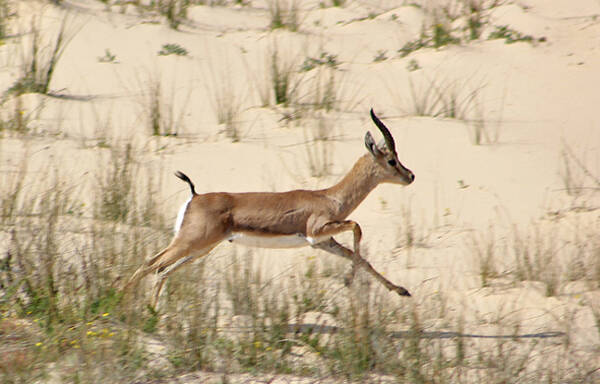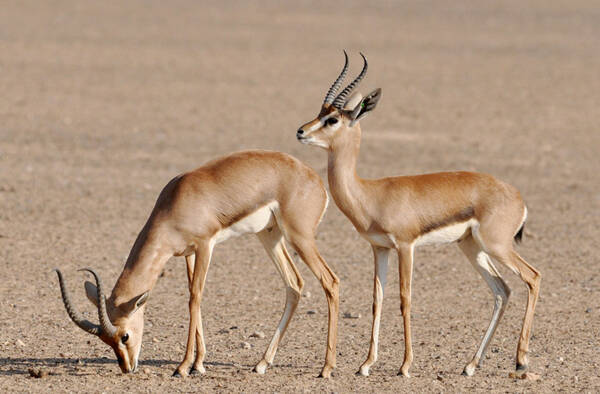Gazella gazella
IUCN
LCBasic Information
Scientific classification
- name:Gazella gazella
- Scientific Name:Gazella gazella
- Outline:Ungulata
- Family:Artiodactyla Bovidae Gazelle
Vital signs
- length:98-115cm
- Weight:16-29.5kg
- lifetime:8-13years
Feature
Dark brown upper body, white lower body, light brown flanks and limbs
Distribution and Habitat
Origin: Israel, Oman, Saudi Arabia, United Arab Emirates, Yemen.
Possibly extinct: Jordan.
Regionally extinct: Egypt, Syrian Arab Republic.
Introduced: Islamic Republic of Iran.
Mainly distributed in the Arabian Peninsula, inhabiting mountains, hills and coastal plains. Mountain gazelles live in low-altitude mountainous areas, sometimes with very steep terrain, but they avoid rocky areas and walking on rocks. They prefer plateaus, hills, foothills and valleys between mountains, open gravel or sandy plains and forest areas, but also occur in true desert areas and coastal dunes. In Saudi Arabia, they usually live in riverbeds in canyons and rolling hills. Mountain gazelles can withstand harsh climatic conditions. They can survive in the very hot and dry Jordan Valley, the Negev Desert and the Dhofar Desert, where temperatures can reach 45 degrees Celsius, and in northern Israel, where winter nights with snow covering the ground and sub-zero temperatures are not uncommon.
Appearance
Mountain gazelle, male head and body length 101-115 cm; weight 17-29.5 kg; female head and body length 98-101 cm; horn length 5.8-11.5 cm; weight 16-25 kg.
Mountain gazelles are dark brown on the upper body, white on the lower body, and light brown on the flanks and limbs. The face is marked with gray-white stripes intersecting with black edges. There is also a narrow dark lateral band that separates the flank and white lower body. The fur color of the lower flank is light yellow. The black tail is short and bushy. The ears are also relatively short. The white dividing line of the lower body reaches the thigh joint. The fur is short and rounded in the summer when the solar radiation is strong, and the fur will be thickened in winter to resist the cold and freezing rain in winter.
Both sexes have horns. Males are 220-294 mm long, and the length of the horns is largely affected by the habitat. The horns of female mountain gazelles in the same group are 70% smaller than those of mal
Details
Mountain Gazelle (scientific name: Gazella gazella) is also known as Mountain Gazelle and Idmi in foreign languages. There are 6 subspecies.

Mountain gazelles gather in groups, usually in small groups of 3-8, sometimes more. The social structure is that of a male leader who has his own territory and maintains a permanent group of several young females. Males compete for control of territory, and when border conflicts occur between two areas, the outcome is usually determined by violent fights. The contestants stop about 30 cm apart and butt each other's heads several times. In a fight between young mountain gazelles trying to occupy the territory of another country, males can cause serious injuries to each other and even break the legs of each other.
Mountain gazelles are typical herbivores. The diet consists of herbs and shrubs, which vary according to the habitat. Mountain gazelles are found in the Arabian Peninsula and Israel, due to the presence of acacia trees in the area, which form a large number of leaves and pods. They usually walk to the branches of acacia trees, stand on their hind legs, and lean on their front legs to eat leaves and pods. Due to the scarcity of local water sources, mountain gazelles dig underground organs of bulbs, corms and other fleshy plants to improve the water balance in their bodies.

Listed in the 2008 Red List of Threatened Species of the World Conservation Union (IUCN) ver 3.1 - Vulnerable (VU).
Protect wild animals and eliminate game.
Maintaining ecological balance is everyone's responsibility!








